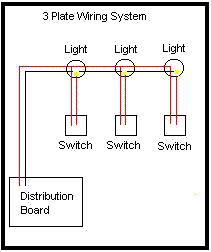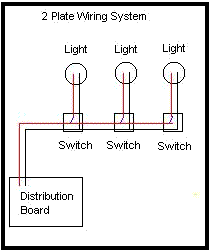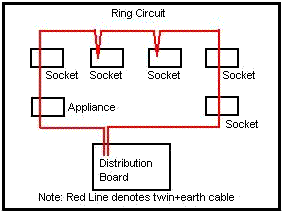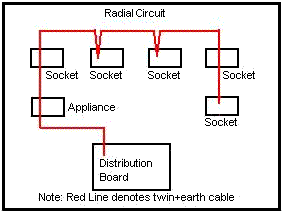Domestic Electrical Wiring
Electricity
can be Dangerous to you, and to anyone using the equipment installed by you.
If you do not feel completely confident in what you are doing, call a professional
qualified electrician!
Please remember, on any work you attempt TURN OFF THE
ELECTRICITY.
Domestic
wiring carries 230 Volts AC, it can EASILY KILL!
You have obviously decided that you are going to install some additional electrical apparatus, so before rushing down to B&Q to buy your equipment, check out the list below, to ensure you remember all the bits that you might require!
-
Cable and Earth sleeving
-
Cable clips and or trunking (capping if the cables are to be burried in the wall)
-
Accessories (switches, sockets, Light fittings etc (if required)
-
Tools (Screw drivers, snips, hammer, drill)
-
Fixings (rawl plugs, screws, etc)
-
Socket or switch back boxs ('Knockout' boxs for mounting in walls, plastic boxs for mounting on walls)
Once you are happy you have the right tools and equipment to start, follow the simple guidelines below:
-
Choosing the correct size cable for the job
-
Earthing
-
Basic light installation
-
Basic socket installation
-
Testing
1.Choosing the correct cable for the job
Choosing the correct size cable for a new electrical installation is crucial. The selection of an incorrectly rated cable could cause the cable to over heat, which may result in a fire.
This guide is not exhaustive, as the 16th Edition IEE wiring regulations stipulate in detail the correct cable sizes for specific installations, and cable lengths.
The table guide below is accurate enough for general domestic installations installed in an average sized 3 bedroom property.
|
Situation cable to be used for : |
Recommended cable size : |
Recommended Fuse / MCB rating : |
|
General Lighting |
1.0mm/1.5mm Twin+Earth |
5 / 6 amp |
|
General Power ring circuit |
2.5mm Twin Earth (x2) |
30 / 32 amp |
|
General Power radial circuit |
2.5mm Twin Earth |
15 / 16 amp |
|
Cookers upto 40 amps MAX load |
6.0mm Twin Earth |
30 / 40 amp |
|
Showers upto 9Kw |
6.0mm Twin Earth |
40 amp |
2. Earthing
Earthing forms an important part of the UK electrical system. All electrical apparatus fixed to the fabric of a property must have an earth connected to it, unless it has been specifically designed not to require one (the appliance you are installing will be 'double insulated' and will have a symbol which looks like 2 squares one inside the other, some where on its body).
The reason bonding is installed as detailed below, is to ensure all extraneous pipe work is at the same potential as earth. This is essentially so that in the event that a cables insulation fails or is damaged and it touches a pipe for instance, it will blow a fuse (or trip an MCB) , rather than leaving the cable, and the pipe it is touching, LIVE!! Obviously this is quite dangerous!!
CROSS BONDING
Kitchens and bathrooms should have all the copper pipe work joined together electrically with a 4mm earth cable.
Bathrooms are a bit of a special subject, for full details refer to the IIE wiring regulations, but as a rule, ensure all apparatus ie, showers, shaver points etc.. have there earths connected to the pipe work of the bathroom (using a 4mm earth cable). Strange as this may seem it is for your protection!
MAIN EARTH BONDING
Gas, Oil and Water services must be connected via a 10mm earth cable to your main electrical earth for the building (usually connected to you distribution board).
3. Basic lighting installation
Lighting installations are generally run (in domestic installations) using twin and earth cables which are chased into the fabric of a building or run in mini-trunking over walls.
Lighting installed using twin and earth can be connected via three methods, 3-plate, 2-plate, and joint box. The 3-plate method is the most commonly used method in new properties today, as it is easy to install and maintain, I recommend where possible, utilizing this method, though when extending circuits for additional points, this is not always possible.
It is important that the earth cables are connected in all lighting circuits!
3-plate Method
The cables are taken from the distribution board (fuse board) to the nearest light, then another cable is linked from that light to the next and so on, until all lights on this circuit are linked together. Then each light that is to be switched separately has a switch wire taken from the light to the switch in that room. - (See 3-plate sketch below)
2-plate Method
The cables are taken from the distribution board (fuse board) to the nearest switch, then another cable is linked from that switch to the next and so on, until all switches on this circuit are linked together. Then from the switch a cable is run to the light that it will operate. - (See 2-plate sketch below)
Joint box method
This method consists of a supply taken from a local source (ie another light or distribution board) which is run to a joint box. The light and switch cables are also run to this joint box, and a supply to the next joint box (if required) also needs to be run from here. This method is only really useful on the extension of existing circuits, as it does take longer than either of the other two methods. Principally it works the same as the 3 plate method


Switching
You can also switch one light from two locations using '2way' switches. You will need a 3core + earth cable to complete this. There are several ways to do this, but for ease try to use this method. Install the three core and earth cable between the two switches you want to control the light with, ensuring one of the switches has already got a switch wire upto the light. (see 2way diagram below).

Note: you will need to use special 2way switches to complete this task.
4. Basic socket installation
The UK electrical system for power installations, is constructed using 'ring' and 'radial' circuits. Ring circuits have rules that must be adhered to, to prevent circuit overloading.
Ring Circuits
These circuits are comprised of a cable connected in a ring ( the cable comes from the distribution board, is run around an unlimited number of sockets before returning to the distribution board). It is important that the continuity of the ring is checked once the circuit is finished.
The principle of a ring circuit is it use two small cables to make one larger one. Ring circuits can have one cable spurred from it, but that cable must have only one socket on the end of it. These circuits, when run in a 2.5mm Twin and earth cable are generally rated at 32 amps MAX (see Sketch 'Ring' below)
Radial circuits
Radial circuits are one cable run from the distribution board to one or more sockets or appliances (ie. immersion heaters), and when run in 2.5mm twin and earth cable are rated at 16 amp. 4mm twin and earth cable or above could also be used, which would allow you to rate the cable at 32 amp. (see Sketch 'Radial' below)


5. Testing
It is a requirement of the IIE wiring regulations that any apparatus altered, or installed should be tested. It should also be noted that periodic inspections should also be executed regularly on the whole installation. Testing is outlined in another part of this site, but you will be required to have the appropriate test equipment to complete this. It is highly recommended that you have electrical apparatus inspected and tested (for domestic properties, these should be inspected at least every 5 years).
For full details contact your local electrical contractor.
Click me to link directly to the testing site